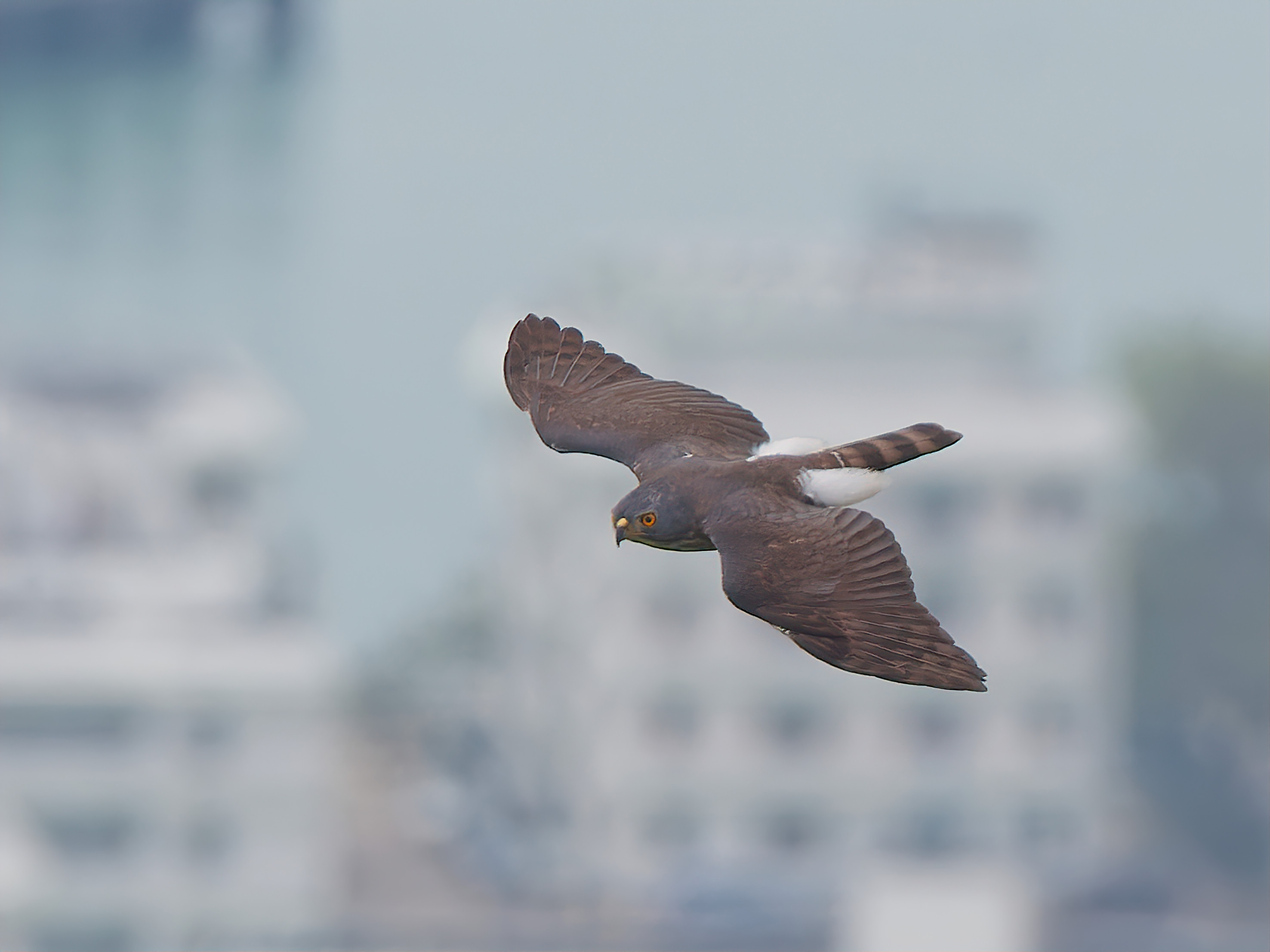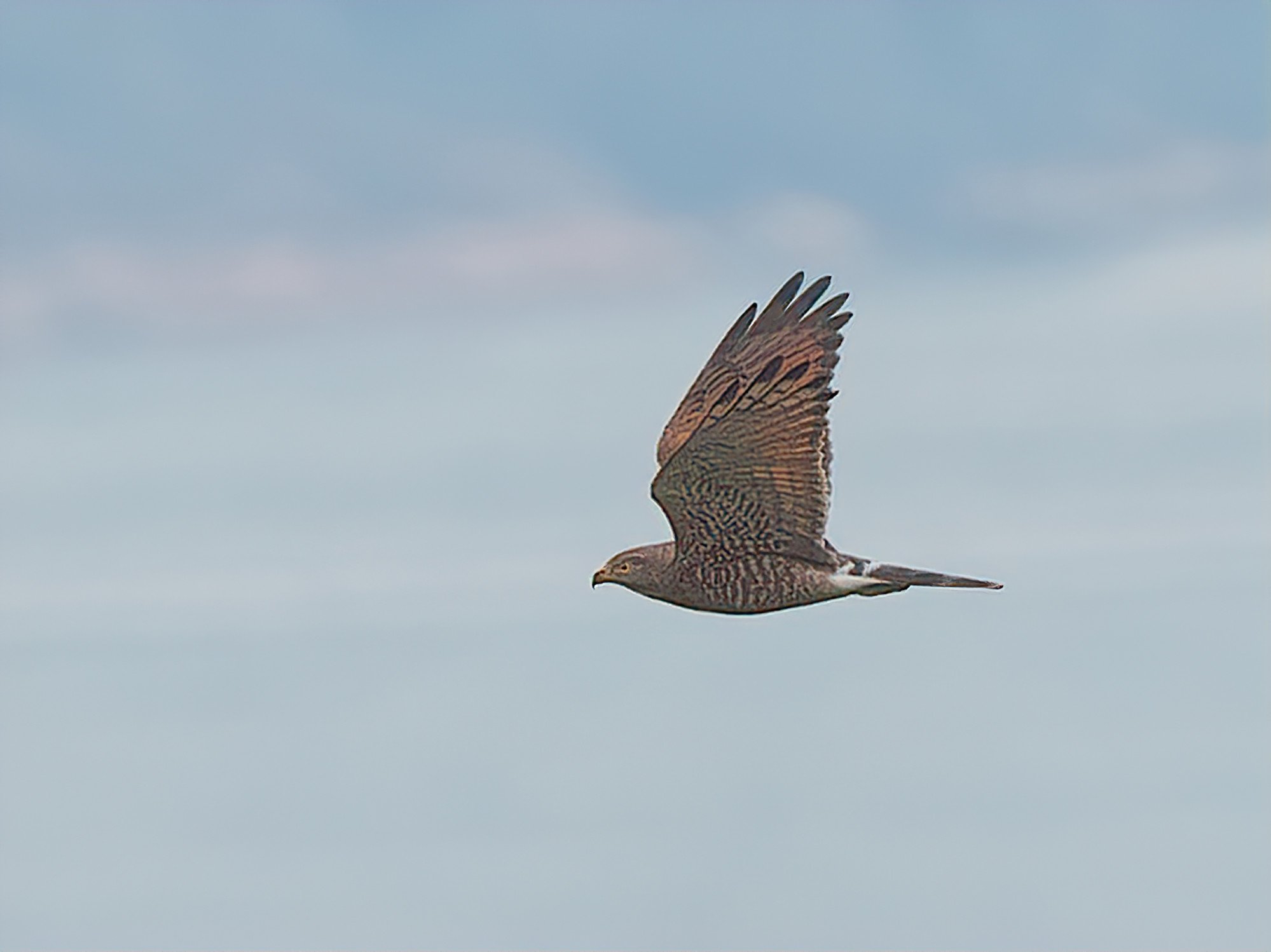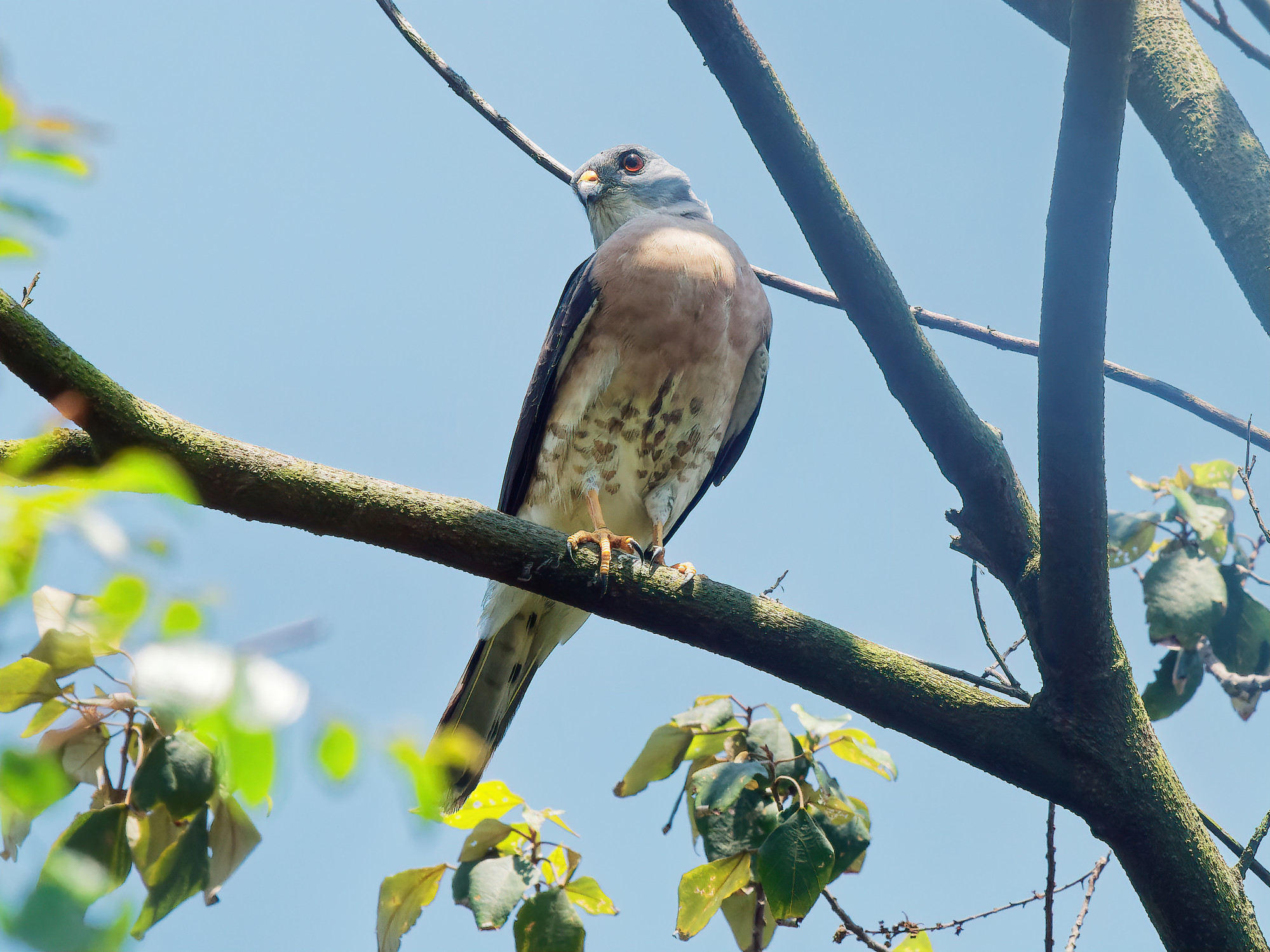
- As raptors grace Hong Kong on a detour from their normal migration routes, a birdwatcher learns the reason is a mix of survival strategy and strong winds
The morning of March 30, I headed to a hilltop vantage above Nam Shan in southeast Lantau. Around 10am, I scanned the horizon over the Chi Ma Wan Peninsula to the south, and saw what I thought was one of the black kites so familiar to Hong Kong, but with thinner wings and a more buoyant flight.
Through my binoculars, I saw the bird was brown on top, pale beneath and had a whitish stripe above each eye, as it passed just east of me, heading north, followed minutes later by several more, gliding on thermals of rising air over the hillside.
I counted 10 in the party, and by the time I left, in the early afternoon, I had tallied 31.
I had been hoping to see these grey-faced buzzards, as this species follows easterly winds through Hong Kong on the periphery of a flyway travelled by around half a million birds a year, on epic journeys of up to 6,000km (3,700 miles) between breeding grounds in eastern Russia, northeast China, Japan and Korea, and winter haunts in the Philippines and Indonesia.
With these easterly airstreams persisting until around mid-April, there were more reported sightings by several observers.
Having spent further sessions watching for them on Lantau, Hong Kong’s biggest island, on April 8, I counted 116, a personal best day total for this species in more than 30 years of birdwatching in Hong Kong.

Up close, grey-faced buzzards are far from glamorous, and with a wingspan of around a metre, they lack the majesty of an eagle. To birdwatchers, however, they are notable for being unique to East Asia, and one of the two main species – along with the Chinese sparrowhawk – travelling the world’s only oceanic flyway for migratory birds of prey.
But being able to understand and analyse these observations was a process that began several decades and a few continents ago.
I began birdwatching as a child in Scarborough, on the east coast of northern England. I was lucky to experience autumn days when hundreds and even thousands of songbirds such as warblers and thrushes arrived on coastal headlands, with a smattering of unusual visitors among them.
Scarborough-born Athol Wallis, a luminary of the local natural history society and an early mentor, once told me, “When we have high pressure over the continent in autumn, that brings fine weather that encourages migration, along with easterlies that can carry Siberian rarities to Britain.”
Though I studied chemistry at my first university, Durham, I continued birdwatching in my free time, and with three friends organised an expedition to study migration in Israel, increasingly known at the time for hundreds of thousands of birds of prey streaming north over the resort town of Eilat during spring, en route between African winter quarters and breeding haunts in northern Europe.
There was less information on the return journeys in autumn, and we spent almost five weeks in September and early October 1982 watching for birds of prey in particular, hoping to shed further light on their populations and behaviour.
We chose vantages such as a rocky ridge overlooking the northern Red Sea, and spent hours watching the skies, with binoculars and telescopes ready to identify and count any birds passing.
As it turned out, we helped show there’s only a trickle of migration over Eilat in autumn compared with spring. But we did enjoy seeing a wide variety of buzzards, eagles, vultures and falcons.
I followed this period with a doctoral course at Cambridge, and while this, too, focused on chemistry, I devised plans for a more ambitious birdwatching expedition.
The scant information available suggested the China coast could be a rewarding location for migration studies, and then Jeffery Boswall, a former BBC Natural History documentary presenter, advised me that Beidaihe, in Hebei province, would be the place to go.
Happily, the university library carried an obscure journal with two papers by Danish scientist Axel Hemmingsen, who had been marooned in this coastal town east of Beijing during the Japanese occupation, from 1942 to 1945, and spent his time making an intensive study of migrating birds.
I read Hemmingsen’s account of what seemed an El Dorado for birdwatchers, with a host of little known and globally rare species, and no follow-up research for four decades.

Putting an expedition together proved challenging, especially as China was only slowly opening after the death of Mao Zedong, in 1976. Yet in mid-March 1985, four of us in the advance party of an eight-member survey team arrived in Beidaihe, a summer resort but with sea ice on the tideline from the lingering winter.
A map showed low hills at the edge of town, and we selected one of these for daily observations. Hemmingsen’s records indicated most spring migrants weren’t due for another four weeks, but Dr George Archibald, then director of the International Crane Foundation, had encouraged our expedition, particularly as Hemmingsen had seen Siberian cranes in late March – and no one knew how many of this highly endangered species might still occur.
Initially, it seemed the number might be zero. We spent five days on the hilltop. Though chilly, the weather was mostly fine and sunny – to us, seemingly ideal for migratory flights, yet over four days only occasional geese passed by, prompting team member Steve Holloway to remark, “What do you call this, Martin? Pretty bird-less I call it.”
Then came a “wave day”, with more than 1,500 geese and 881 cranes. They flew in V-shaped flocks, making for a superb spectacle against the blue sky, especially the cranes, which included endangered Siberian cranes, gleaming white with black wing tips. Occasionally, crane flocks broke formation above us, soared on rising air, then regrouped and continued northwards.
It turned out, barely noticed by us, a change in the weather had produced a southerly airstream along the coast, ideal for assisting northbound flights.

During this first survey and several return visits to Beidaihe, I learned cranes are not just fair-weather fliers: most judge factors such as changing temperature and air pressure so they can maximise the chance of tailwinds and travel hundreds of kilometres between far-flung wetlands.
One autumn day, there was an indication of what can go wrong if the cranes fly in adverse conditions. A fisherman was out in a boat, and saw a juvenile red-crowned crane fall into the sea from exhaustion.
Knowing the species was protected – and perhaps hoping for a reward – he rescued the youngster and took it to the local government. I happened to be in town for a survey, and was called in to give advice.
“You can feed it small fish, and maybe give antibiotics as for a small child,” I suggested. The fisherman said it was one of three cranes flying together – surely the parents with their offspring, crossing a bay despite a headwind.
Luckily for the crane, it was cared for until staff from a reserve arrived and took it to their wetland for release. Countless other birds perish during migrations, however, and it’s the combination of successes and failures that develops and fine-tunes strategies, such as which routes to favour and preferred weather for flying.
For many migrant species, this has led to them avoiding lengthy sea crossings, and following features such as coastlines, valleys and edges of mountain ranges – concentrating them along flyways, which are like seasonal rivers of birds.

Eilat and Beidaihe are among the places on the world’s greatest flyways, where birdwatchers can revel in the spectacle of thousands or even hundreds of thousands of birds passing over in a day, and dedicated observers record high proportions of species’ world populations, much like we recorded 652 Siberian cranes – 40 per cent of the known world population – passing Beidaihe in the spring of 1985.
In early 1987, I arrived in Hong Kong, planning to live there while encouraging bird conservation at Beidaihe. I knew little of the birdlife other than a reserve called Mai Po being outstanding for wetland birds.
Helped by members of the birdwatching society, I quickly learned that while there’s a rich diversity of bird species, Hong Kong does not lie on a flyway with migrants readily seen passing overhead.
So I was surprised when, one day in March 1993, I glanced above my home on Cheung Chau and noticed a flock of grey-faced buzzards circling above. I grabbed my binoculars, and counted 42 birds; and later learned another 56 were seen over Aberdeen Country Park on Hong Kong Island, with 228 passing Hong Kong the next day.
At the time, this seemed like just a lucky couple of days. But the next year I co-authored a paper on connections between weather and Hong Kong birds with birdwatcher and then director of the Hong Kong Observatory, Lam Chiu-ying.
After searching Hong Kong bird reports for notable sightings, we realised that spring pulses of grey-faced buzzards coincided with easterly airstreams over the South China Sea, and figured these birds had come from somewhere to the east of Hong Kong.
I remembered that while I was planning the first Beidaihe survey, I met Nigel Collar, compiler of the BirdLife International Bird Red Data Book (2001), who told me, “Birdwatchers in Taiwan have recently discovered tens of thousands of birds of prey passing over the southern tip of the island in autumn. They must make a long sea crossing to the Philippines.”
So perhaps the Hong Kong birds were aiming to take the reverse route in spring, but were deflected by the winds over the sea.
The typical weather patterns bringing easterly winds also fit this notion. High pressure systems pushing down from the mainland almost guarantee fine weather between Luzon and China – so, much as the cranes passing Beidaihe favour conditions for safely reaching wetlands, the grey-faced buzzards boost their chances of making the long sea crossing without encountering potentially fatal rainstorms.
And if they happen to drift off course towards Hong Kong and nearby, that’s a small price to pay for ensuring survival.

During the 1970s, Taiwanese birdwatchers realised it was humans rather than adverse weather that posed the greatest threat to migrating grey-faced buzzards. The issue evidently started with locals hunting them as precious gifts for family and friends, but snowballed as a cottage industry developed, supplying people in Japan who followed a tradition that having a mounted bird of prey could bring good fortune.
The numbers traded were alarming: between 1976 and 1977, about 60,000 grey-faced buzzard skins were shipped to Japan.
Conservationists in Taiwan and Japan fought to save the species, achieving measures such as legislation that closed the Japanese market in the early ’80s, and a ban on hunting the species at the beginning of the ’90s.
“The story of the effort to save the grey-faced buzzard is one that Taiwan can truly be proud of,” wrote birdwatcher Mark Wilkie in an online article.
Even with conservation efforts, the numbers of grey-faced buzzards recorded passing southern Taiwan in autumn remained steady at about 10,000 from 1989 to 2003, but the tallies have since risen, to a record of 110,000 last year. Instead of being hunted, the migrating flocks have become a tourist attraction, with locals now promoting “eagle-viewing” and some former hunters working as guides.
In tandem with direct observations, researchers have also used radar to detect grey-faced buzzards. This revealed that in spring, the northbound birds of prey mainly travel over or near Taiwan – helping explain why, on typical days, only strays reach Hong Kong; and they can travel at up to 50km/h.
Given that Hong Kong is about 800km from the northern tip of Luzon, this means at least 16 hours of non-stop flying for birds departing the Philippines to reach Hong Kong.
Another Taiwanese study providing insight for Hong Kong involved fitting grey-faced buzzards with satellite transmitters. After four individuals headed south for winter, they were tracked during the spring migration, including their flights from Luzon.
While three passed over Taiwan, one made landfall on an island in western Guangdong province. “It was hampered by several days of strong northeast monsoon winds, but it fought its way across the sea,” reported an article in Taiwan Today – supporting the conclusion of Lam and I that pulses of these birds in Hong Kong result from easterly airstreams deflecting them off course.
Based on his extensive observations of migration on Po Toi, Hong Kong birdwatcher Geoff Welch believes many birds arriving over the sea in spring first rest on Dangan and other islands south of Hong Kong.
These include grey-faced buzzards – and Chinese sparrowhawks, which are more abundant along the flyway – and pass a little later in spring. On some days, Welch witnessed flocks of these birds passing Po Toi, most notably on April 14, 2010.

Reporting on the Hong Kong Bird Watching Society forum, Welch noted, “1,440 Chinese goshawks [aka sparrowhawks] flew through Po Toi this morning between 9.30am and 11.30am, a spectacular sight.
“This movement took place right through the harbour, the birds passing at heights mostly below 200 feet in a steady stream with more than one thousand birds between 10.30 and 11.30am.”
Given they also travel the oceanic flyway, these sparrowhawks appear in similar weather to grey-faced buzzards – and with further easterlies during the second half of April this year, I headed to Lantau in hopes of seeing them.
While previous Hong Kong records were mainly from lower, coastal sites, Lantau-based naturalist Paul Aston had tried a higher lookout, near Ngong Ping, finding it productive for birds of prey, and I made several morning visits to this area.
Perched on a hilltop behind the Big Buddha statue there, I could gaze out across hillsides cradling Shek Pik Reservoir, and hope the Chinese sparrowhawks were coming. I was not disappointed.
Sparrowhawks in twos and threes, and parties of up to eight, arrived from the south, circling way below, and rose before cresting the hills and cruising north. Others seemed to appear from thin air right in front of me, so close I could admire their blue-grey upper parts and heads, rusty-orange bellies and pale underwings with dark tips.
Chinese sparrowhawks are smaller, more agile than grey-faced buzzards, and I watched seven spiral upwards until almost lost from view.
Though I missed a morning when a lucky observer saw 180 Chinese sparrowhawks over Lantau, I did manage a three-figure tally – 101 birds – on May 3, when for an hour or so they streamed over the hills in quick succession before tailing away.
By then, even early mornings were hot, and the spring migration was coming to a close. Two days later, I returned and recorded a very round number of migrating birds of prey: zero.
In autumn, the grey-faced buzzards and Chinese sparrowhawks are again travelling the oceanic flyway, but only a few are seen in Hong Kong – and at least some of these might be individuals taking an alternative, mainly overland route via the Malay Peninsula, as they occur along with species such as the oriental honey buzzard, known to favour the long way round to Indonesian winter areas.
So why do many grey-faced buzzards and Chinese sparrowhawks choose to follow the oceanic flyway while others opt to mostly fly overland, even though they might breed and spend winter in similar areas? As yet, no one has the answer.
For myself, I’m also curious about what this autumn might bring. Usually, migrating birds of prey are sparse in Hong Kong in autumn. But last year, several hundred were seen, including Amur falcons, which undertake astonishing journeys from northeast Asia to India and onwards to Africa.
Was this a fluke, arising from powerful northeast monsoon winds, or might time spent watching, such as on the “new” Lantau vantage, prove rewarding? I’m hoping the latter proves correct.
But if the autumn migrations flop, at least the views are good. And I can reflect that, especially while confined to Hong Kong in these Covid-19 times, we’re lucky to witness something of the migrations of these birds, and gain insights regarding their strategies for surviving and thriving by undertaking long, perilous journeys along the west Pacific Rim.

